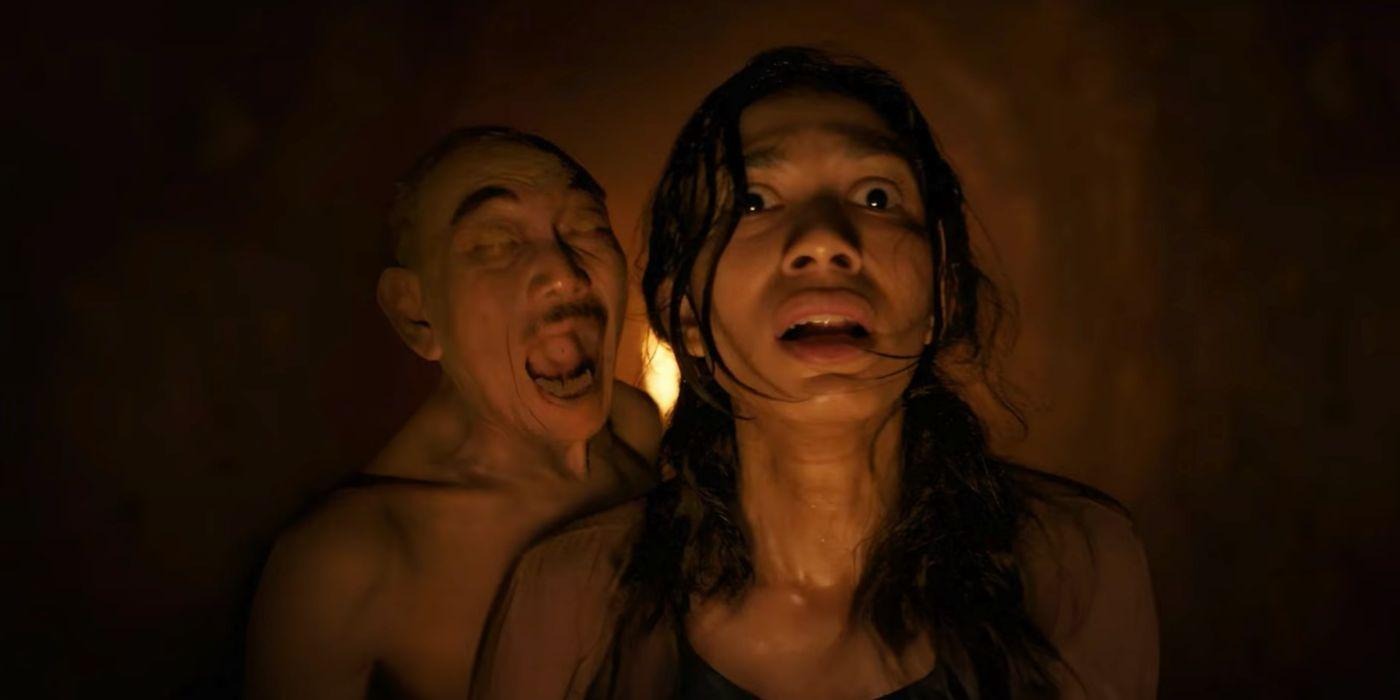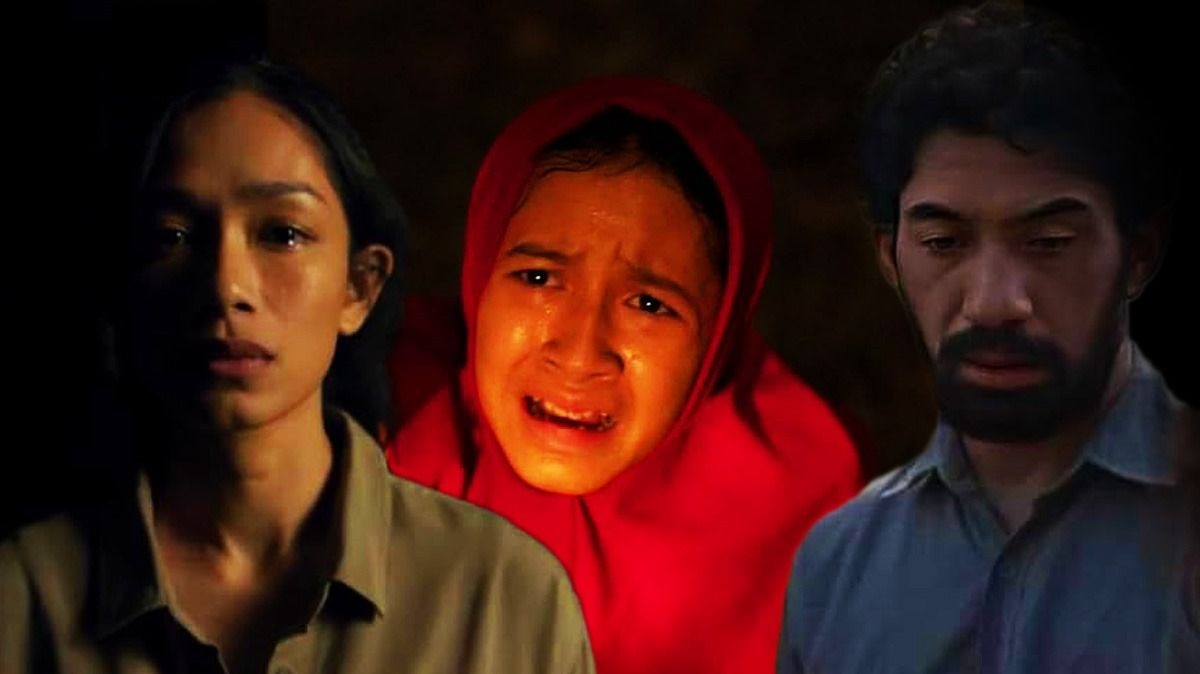Joko Anwar has once again taken a bold step in horror cinema with his 2024 release, Grave Torture (original title: Siksa Kubur), though this particular film raises mixed feelings. The storyline manages to hold your attention with its haunting subject matter, yet it drifts apart by the time it concludes.
It leaves behind a sense of disconnection. The movie opens with a clear message and problem, but later events appear to reject what was introduced earlier. By the time Grave Torture reaches its closing scenes, questions hang not just around what happened but also around the values and warnings the film is trying to deliver.

Before going into how the film ends, it’s worth revisiting some key developments that shaped the story.
How did the grave torture experiment backfire?
After Wahyu passed away, Sita made the unusual decision to keep watch over his body through the night. Adil had already dug the grave, and Sita climbed in with a camera that had infrared capability.
Her goal was to collect proof that grave torture had no basis in reality, especially to challenge violent actions by extremists who claimed to act on behalf of divine judgment. During the night, nothing terrifying happened. By morning, Sita got out of the grave to share her experience publicly.
She appeared on a TV program to speak against blind religious belief and fanaticism, but the footage she recorded failed to play. She became a laughing stock for attempting to challenge religious authority, and this crushed her spirit.
Her life’s mission had been to disprove this age-old belief, and yet again, she felt like she had failed. Not long after that, Sita began encountering strange apparitions. Demonic figures started appearing to her, and the environment at the old-age home where she stayed grew darker.
One of the residents, Nani, was deeply hurt after finding her husband, Mr. Pandi, involved with a nurse named Lani. She confided in Sita, who advised Mr. Pandi to give Nani time and space. The emotional weight on Nani became too much, and she began to unravel.
After wetting herself, she tried to wash her clothes and noticed her wedding ring was missing. While searching for it inside the washing machine, she mistakenly turned it on with part of her body still inside, which led to a gruesome accident that claimed her life.
Mr. Pandi blamed Sita for Nani’s death, and Sita found herself caught in yet another downward spiral. Despite not believing in the spirit world, she held a séance to bring Mr. Pandi some comfort. But when Nani’s spirit encouraged her husband to kill Lani, Sita tried to end the session.
What shocked her was seeing Nani seated beside her, like something demonic was punishing both her and Adil. While she was battling with terrifying events at the home, Adil was being tormented at the morgue by ghosts of deceased individuals.
Things took a deadly turn when the residents of the home stabbed Lani. Although Sita offered help, Lani refused, choosing instead to end her own life. Sita questioned why they acted that way, and their answer was tied to fear—fear of grave torture.
Sita had publicly dismissed the idea of grave torture, and her challenge led others to test her claims. After people began spending nights in graves, some recordings picked up disturbing sounds. This caused global panic, as many tried to prove their interpretations of spiritual truth.
Did Sita witness grave torture?
Driven by the need for answers, Sita returned to Wahyu’s grave, unwilling to believe he faced no punishment despite his wrongdoings. But when she dug up the grave, the body was missing. Before she could react, she was pulled into a supernatural realm.
She found herself back in the same tunnel she and Adil had earlier passed through. While she tried to convince herself it was all a mental illusion, the vividness of the experience made it hard to believe that. She encountered Ismail’s spirit again, as well as a broken-down version of Adil.

Her journey led her to the bakery her parents once owned. As she observed events from her past, it became clear that her obsession with exposing religious myths had kept her from grieving properly. The tunnel somehow allowed her to emotionally let go of her parents.
After finding Ismail again, Sita managed to rescue his spirit from Wahyu. When he died, Ismail had cried out for help, and Sita was now able to assist him in crossing into the afterlife. She eventually regained consciousness, still lying in the grave, with the camera beside her.
During the movie’s final moments, Sita came to believe that the holy scriptures might be true. She saw the gruesome torture Wahyu went through and was shaken enough to rekindle her religious faith. She begged for forgiveness and hoped for mercy.
A faint glimmer of hope appeared when her brother opened the grave and reached out to her. He helped her out, but Adil remained badly hurt. Suddenly, a muffled voice asked her who her God was. From the look on her face, it could have been the angels spoken of in religious texts.
This raised the possibility that Sita didn’t survive the experience, and perhaps everything after falling into the grave was her spirit’s journey. The question from the voice might indicate she had reached her moment of reckoning.
On the other hand, that voice might have belonged to a religious extremist who hunted those who denied religious beliefs. There are signs suggesting Sita’s grave experiment did not end with her survival. The part where she comes out unharmed and events spiral might have been just an alternate reality.
The purpose of this imagined version could be to show how much unrest can arise from public rejection of religious beliefs. If Sita had succeeded in sharing her ideas on television, more people could have lost faith and begun questioning scripture on their own.
This, in turn, could have led to confusion and violence. The message hints that without belief systems, humans could give in to their darkest impulses, like Mr. Pandi’s infidelity or Lani’s emotional instability due to childhood neglect.
What the movie pushes forward is the notion that fear created by religion serves a purpose—it helps guide people away from evil by giving them a moral anchor. At the final moment, the condition of Sita’s clothes suggests she never made it out of the grave alive.
Her punishment, along with Adil’s, was brought on by their decision to challenge religion rather than try to understand it.
What Sita’s Ending Reveals
During the final moments of Grave Torture, Nani’s hand appears with the wedding ring, indicating that she and Mr. Pandi were still a couple, which suggests the earlier tragic events might not have been real. Wahyu had mentioned before dying that punishment in the afterlife is tailored to a person’s greatest fear.
Since Sita’s worst fear was discovering the truth behind grave torture, that became her fate. Her punishment was to witness the truth and realize that all her efforts were focused on proving the wrong point. The film ends by showing a clash between personal search for truth and blind devotion.
Sita’s mission was born out of rational thought and curiosity, but her outcome—being condemned for seeking answers—felt harsh and unjust.



